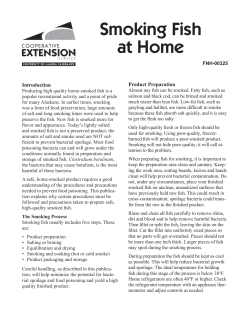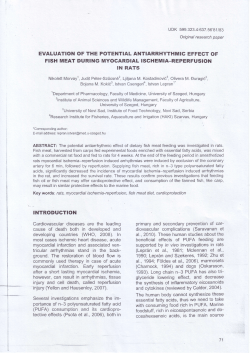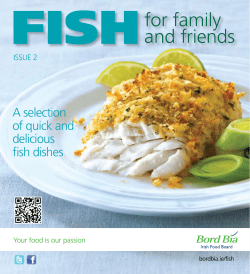
and fish, keeping the skin sides of the fish layers
and fish, keeping the skin sides of the fish layers adjacent. With the top layer of fish, place the fish skin side up. Hold under refrigeration if possible. Do not store above 50˚F. Brine curing Place sides of fish into saturated brine (about 1 part fine kosher salt to 3½ parts water) and completely submerge them with a clean weight or use a container that has a lid that can be used to keep the fish submerged during the entire brining process. Use about equal volumes of fish and brine. Place the top layer of fish skin side up. Hold under refrigeration if possible. Do not store above 50˚F. Pickling 4. Remove the surface brine by rinsing fish in cold fresh water using a process called “freshening.” Soaking the fish (not longer than 1 day) in cool, fresh water to reduce salt content may be desirable, but is not necessary. The length of freshening depends on the salting method used, the type of fish and size of the pieces, and the amount of salt desired in the finished product. 5. Remove the skin if desired. Some fish can be skinned easily prior to salting, but storage life may be reduced if this is done. 6. Cut fish into bite-size pieces or strips, as desired. 7. Place fish loosely in clean glass jars (not cans!) that have been sterilized with boiling water. Jars, closures (caps and liners), and tongs for handling the jars and closures can be sterilized by placing them in boiling water for 5 minutes. Cover with the pickling solution, put on lids, and keep under refrigeration until the bones soften (1–2 weeks). A Basic Pickling Solution Table 1 provides the formulation for a common pickling solution for a Scandinavian-style pickled herring. One gallon of solution will pickle 6–7 pounds of fish (about 2 gallons of finished product). Two liters of solution will pickle about 1.5 kilograms of fish. Important: Do not use less than one part vinegar to one part water. Do not pack fish tightly into jars. Do not pickle more fish in a given amount of pickling solution than the amounts indicated in the preceding paragraph. Storage If you follow this basic recipe, you should produce a safe, good quality product. However, the fish must be stored under refrigeration (38˚F) to provide an added measure of safety. This will ensure that food poisoning bacteria will not grow. Refrigerated storage also will retard bacterial spoilage, reduce problems with enzymatic softening, and reduce discoloration. If refrigeration facilities are limited, do not pickle more fish than you can consume in a few weeks. For Further Reading Canning Seafood, PNW0194 Smoking Fish at Home—Safely, PNW0238 Home Canning Smoked Fish, PNW0450 Home Freezing of Seafood, PNW0586 Revised by Dr. Barbara Rasco, Washington State University; originally prepared by Kenneth S. Hildebrand, Jr., Oregon State University. Pacific Northwest Extension publications are produced cooperatively by the three Pacific Northwest land grant universities: Washington State University, Oregon State University, and the University of Idaho. Similar crops, climate, and topography create a natural geographic unit that crosses state lines. Since 1949, the PNW program has published more than 600 titles, preventing duplication of effort, broadening the availability of faculty specialists, and substantially reducing costs for the participating states. Pacific Northwest Extension publications contain material written and produced for public distribution. You may reprint written material, provided you do not use it to endorse a commercial product. Please reference by title and credit Pacific Northwest Extension publications. Issued by Washington State University Extension, Oregon State University Extension Service, the University of Idaho Cooperative Extension System, and the U.S. Department of Agriculture in furtherance of the Acts of May 8 and June 30, 1914. Extension programs, activities, materials, and policies comply with federal and state laws and regulations on nondiscrimination regarding race, sex, religion, age, color, creed, or national or ethnic origin; physical, mental, or sensory disability; marital status or sexual orientation; and status as a Vietnamera or disabled veteran. Washington State University Extension, The Oregon State University Extension Service, and University of Idaho Extension are Equal Opportunity Employers. Evidence of noncompliance may be reported through your local Extension office. Trade names have been used to simplify information; no endorsement is intended. Revised April 2007; reprinted April 2009. $1.00 PNW0183 Pickling Fish and Other Aquatic Foods for Home Use PNW0183 PACIFIC NORTHWEST EXTENSION PUBLICATION WASHINGTON OREGON IDAHO Preserving seafood with acid, usually vinegar (acetic acid) or citrus juices (citric acid), is one of the earliest food preservation techniques known. This is a common method of fish preservation in many parts of the world and is often an integral part of several ethnic cuisines. Fish preserved in this manner is often not thoroughly cooked (and may not be cooked at all), making these products potentially dangerous if not properly prepared. This pamphlet will provide some instructions on how to make these foods safely. West coast and Pacific Northwest states have several species of fish that lend themselves well to pickling: shad, salmon, herring, shrimp, shellfish, and sea vegetables are some examples. These marine products are relatively plentiful, little work is involved in their preservation, and the products are often delicious. Fish with high oil content make the best pickled dishes. In addition to shad and herring, other common west coast species that work well are Chinook salmon, sturgeon, candle fish, anchovies, sardines, striped bass, and black cod (sablefish). Other species, such as cod, whiting, or ling cod, are also suitable, depending upon individual preferences. These different species may require slight modifications in preparation techniques, but following the basic steps outlined below will provide a good beginning to developing your own special recipe. Safe and tasty fish pickling recipes all have one thing in common—they use enough acid to prevent the growth of the food pathogen Clostridum botulinum. Although rare, botulism is a serious disease and an important concern in all food preservation processes. By following some simple rules, you can ensure that your favorite pickled fish is safe as well as delicious. This publication outlines the basic steps in pickling aquatic food products, offers some helpful hints on preparation, and provides a basic recipe that works well on most fish with high oil content. The Basics—Salt Curing and Brining Most good fish pickling recipes call for salt curing prior to brining in an acidic pickling solution. This step removes some unwanted bacteria and slows the growth of others, reduces the water content, firms up the muscle protein for a good texture in the final product, and reduces the level of activity of some of the enzymes in the fish that can cause the protein to break down during storage—a process that are quite basic and can be modified to individual would reduce product quality. taste preference (Table 1). However, never use a soluFish that is dried as well as salt-cured may be tion with less vinegar than water. preserved without refrigeration and can be stored for If the flavor of the vinegar is too strong for your extended periods before pickling. It is not common taste, change the type of vinegar used, or substitute these days to make pickled products from salty dried lemon juice for part of the vinegar. Another trick is fish, although this can be the starting material for to add more sugar to offset the strong vinegar flavor some products, including those made from cod or (try doubling the amount of sugar to start.) shrimp. It is more common now to use dry salt or a brining solution to cure the fish under refrigeration The Procedure (preferably at 38˚F or lower). Fish is usually cured to The following are basic steps in pickling fish. Not all 1.5–5% total salt, depending on the taste desired. Affish can, or should, be treated exactly the same, but ter the fish is cured, it is placed in the pickling brine. the steps are similar. This procedure salt cures the It must be refrigerated and has a limited storage life fish. If you skip the curing step, use only previously (4–5 months). frozen fish. In recipes that don’t call for salt-cured fish, use only previously frozen fish (that was held at least 3–4 Preparation days in the average home freezer). This will ensure 1. Remove the entrails, clean, and remove head and that no live parasites are present in the raw fish, scales from whole fish. which is particularly important for lightly-salted and 2. Remove backbone in large fish by cutting lengthmarinated recipes. wise. This is not necessary on small fish such as Adding organic acids (vinegar, lemon, or lime herring. juice) will limit the growth of most food pathogens 3. Dry salt or brine cure 5–8 days. Salted fish may be and many of the bacteria responsible for food spoilstored in a cool place (preferably under 50˚F) for age. The acid will also give flavor to the product, de2–3 months before pickling (6–12 months under velop the desired texture, and soften bones. However, refrigeration). the acid will not preserve the fish indefinitely—it will only slow spoilage and softening caused by enzyme Dry salting action. The concentration of acid (from the vinegar) Cover bottom of large pan with about ¼ inch must be high enough to prevent botulism by reducing (0.5–1 cm) of fine kosher salt, then place a layer the pH (a measure of acid strength) of the product to of fish skin side down. Alternate layers of salt below 4.6. This pH is important so that Clostridium botulinum will not grow in the product. Growth of food poisoning bacTable 1. Recipe for a basic pickling solution (English and metric units). teria will be prevented when the start Amounts Amounts ing pH is below 3.5. From a practical (to make about (to make about standpoint, this acid level is attained Item 1 gallon) 2 liters) when the pickle solution contains one Water 3 pints 750 ml or more parts of 5% vinegar to one Vinegar (5% white) 4 pints 1000 ml part water. Sugar (granulated)* 2 cups 240 ml Salt (table salt) 4 Tbsp 30 ml The Recipe Spice (mixed pickling spice)** ¾ cup 110 ml Most pickling recipes contain vinOnion (white, chopped, or rings) 2 small 1 small egar, sugar, salt, spices, and onions, Garlic (dry, chopped)*** ¼–½ tsp 2–4 ml although many are much more simple. *For a sweet, Swedish-style pickle, add more sugar to taste. Items other than vinegar really do **Use a spice blend that does not contain red peppers for a milder taste. little to preserve the fish, but they can ***Optional. One or two chopped fresh garlic cloves can replace the dry, chopped garlic. add to good flavor. The ingredients NOTE: Increase all ingredients proportionally to make quantities greater than 1 gallon of the pickling solution offered here (2 liters) and always use more vinegar than water.
© Copyright 2025
















